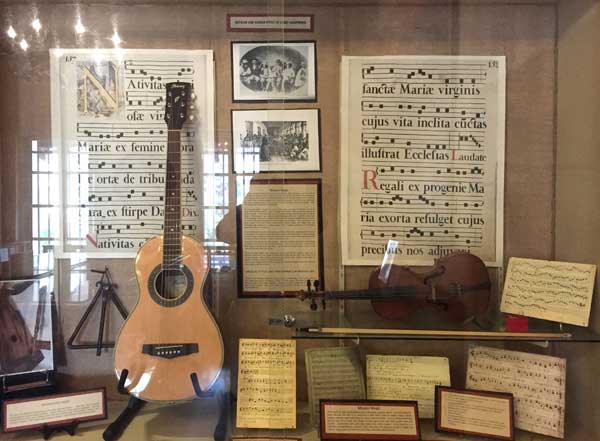|
 |
| The Mission of San Luis Obispo is unusual in its design, in that its combination of belfry and vestibule are found nowhere else among the California missions. |
| |
 |
| Visiting the San Luis Obispo mission today, a visitor is greeted by a sculpture fountain with a momma bear two cubs and a native Chumash child. Photo includes Al's wife, Adele, and daughter, Debra Star. |
| |
 |
The rear of the building has a lovely garden and the building's interior houses a museum including a selection of period musical instruments.
|
As a relatively new arrival in California, I've looked about at the state's relatively long history. One part that I've always been curious about is its Spanish mission trail.
What is now the state of California began its colonization stage as the northern portion of New Spain/California called Alta California. To develop this territory, between 1769 and 1833, the Spanish Franciscans established 21 missions.
Besides serving as way-stations covering the 600-miles between San Diego and San Francisco, the missions served to covert/enslave the Native Americans to achieve Spain's development of the territory.
The missionaries forced the native Californians to live in settlements called reductions, disrupting their traditional way of life. as they tried to convert, educate and transform the natives into Spanish colonial citizens.
The 21 missions were located about 30 miles apart, about one day's journey on horseback. Tradition has it that the padres sprinkled mustard seeds along the trail to mark it with bright yellow flowers.
I recently visited the Mission San Luis Obispo de Tolosa - founded 1771 by Father Junípero Serra. Unlike other California missions, the San Luis Obispo Mission is open to the public every day of the year and is still a very popular parish for the town's Catholic community.
The Mission of San Luis Obispo is unusual in its design, in that its combination of belfry and vestibule are found nowhere else among the California missions. Like other churches, the main nave is short and narrow, but at the San Luis Obispo Mission, there is a secondary nave of almost equal size situated to the right of the altar, making it the only L-shaped mission church in California.
.
|
The name "Obispo" goes back to the discovery of the area in 1769 and was referred to as "llano de los osos," or the "level of the bears." Various mistranslations morphed "osos" into "Obispo".
Because of its game, natural resources, good weather and a friendly native tribe, San Luis Obispo became the site of the fifth mission in the chain.
Visiting the San Luis Obispo mission today, a visitor is greeted by a sculpture fountain with a momma bear two cubs and a native Chumash child.
The rear of the building has a lovely garden and the building's interior houses a museum including a selection of period musical instruments.
My family and I visited San Luis Obispo for Passover 2019, I found a curious connect ion between our Passover service and San Luis Obispo.
As Passover is a commemoration of the Exodus of the Hebrews from Egypt, I was drawn to the curious mashup medley, "Over the Rainbow" / "What a Wonderful World" that became Israel Kamakawiwo'ole's legacy.
In particular, "Over the Rainbow", which has since been voted best sonf of the past century, and is a veiled homage to lyricist Yip Harburg's Jewish brethren who came over the rainbow to the US from Eastern Europe—and a foreboding of the Holocaust that was fermenting in Germany.
The song was deleted from the film after a preview in San Luis Obispo because MGM thought it "slowed down the picture". But the song was returned to the film and won the Academy Award for Best Original Song.
~ Al Zagofsky
(Note: Various portions of this article were excepted from Wikipedia.) |
